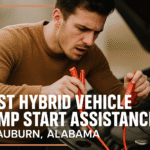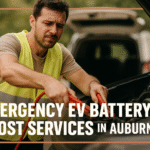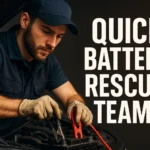There is nothing frustrating as inserting your car key and getting a click or total silence. You do not want to find yourself in a situation when a flat battery catches you, on your way to work, doing some errands or picking up the kids. Daily driving, as it is a requirement in Auburn, AL, can help save time, money, and stress when one understands how to safely jump start his or her car.
The point is the good news as, when proper actions are taken, there is no need to make jumping starting a car seem dangerous or complicated. Incorporating safe measures and understanding when they should seek professional roadside jump start services, Auburn drivers will be able to be back on the road within a short time with a strong amount of confidence. We will take a stroll over all you require to know.
What You Need Before Attempting a Jump Start
You are supposed to have the right tools and safety set up before you are taught how to jump a dead battery in Auburn. Here’s what you’ll need:
- A set of jumper cables – Well-insulated thick cables are preferable.
- A second vehicle with a charged battery – Should be of the same voltage (typically 12V).
- Protective gear – Safety glasses and gloves can be used.
- A safe location – Flat and free area without traffic.
Unless you are equipped with these items, or are not sure, it is always on the safe side to call on professional jump start services in Auburn.
Step-by-Step Guide for Safe Car Jump Start
Now let’s go in depth. In this section, we are going to take you through a safe jump start process that the Auburn drivers can use. Read thoroughly and take your time, do not hurry.
Step 1: Park the vehicles safely
Why: You want the cars so that they are never in contact and so that they are in the same place, but not touching.
How to do it:
- Face the dead car with the live car, nose-to-nose, or side-by-side to enable cables to reach.
- Put both cars, park (automatic) or neutral (manual).
- Turn on the parking brakes of both cars.
- Radios, lights, heaters, and accessories both in cars should be switched off.
Safety tips & common mistakes:
- Never leave your car on a hilly place where vehicles may roll.
- Do not allow cars to contact each other during use of metals, the contact between metals may be short-circuited.
- Get children and pets out of the scene.
Step 2: Open the hoods and locate the batteries
Why: You have to locate the battery terminals and see whether there is any damage or corrosion.
How to do it:
- Open the two hoods and prop them open.
- Find the battery. The battery can be under a seat or under the trunk on some cars – see owner manual in case you are in doubt.
- Trace the terminals: positive (and in most cases it is red) and negative (and in most cases it is black).
Safety tips & common mistakes:
- Don’t lean over the battery. There may be leakage of acid in batteries or gaseous emission.
- In the case of heavy corrosion (white/green powder), wipe with a cloth. In case of severe corrosion, do not skip the battery and call a professional.
- Do not connect both terminals simultaneously with a metallic object.
Step 3: Attach the jumper cables correctly (order matters!)
Why: Proper order minimizes the risk of sparks and safeguards electronics.
How: (do it in the following sequence):
- Grab the red (+) line to the positive (+) terminal of the dead battery.
- Connect the other red+ cable to a positive (+) terminal of a good battery.
- Connect the black (-) cable to the negative (-) terminal of the good battery.
- Connect the last black (-) wire to a clean, unpainted metal object on the engine block or body of the dead car – not to the negative terminal of the dead battery. A bolt or bracket works.
Why the last clamp goes to metal:
- It bases the relation beyond the battery. This reduces the possibility of any spark igniting any hydrogen gas around the dead battery.
Safety tips & common mistakes:
- Ensure that clamps are not in contact.
- Make sure that clamps are clamped on metal, not on parts that are painted, or that are plastic.
- When connecting, make sure that the clamps are not lost by sliding them off, otherwise re-seat them.
Step 4: Start the working vehicle
Why: This is because the charged battery should supply power to the dead one.
How to do it:
- Turn on the starter of the donor (good) car.
- Let it idle for 2-3 minutes. Provided you desire, raise the engine RPM slightly (around a few seconds) to charge more (do not rev hard).
- Leave the cars in neutral/park with parking brakes on.
Safety tips & common mistakes:
- Do not race the engine – revs gently only.
- Look at the cables – when any of the clamps sparks, then halt and re-fix clamps.
Step 5: Start the dead vehicle
How to do it:
- Try to start the dead car. If it starts, let it run.
- In case it does not boot up, wait up to 30-60 seconds and restart.
- In case it is not going to start even after 3-4 attempts, it means that either the battery is too weak or there is another problem (starter, alternator). Call for help.
What different outcomes mean:
- Starts immediately: Good sign – the battery was charged sufficiently.
- Slow crank, then starts: Battery was very low but recovered. Let it run.
- Clicking noise but won’t start: It may be a weak battery or poor connection. Recheck clamps and try again.
- No sound at all: It might be a faulty battery, faulty starter, or blown main fuse – get a pro.
Step 6: Remove cables in reverse order
Why: This is to remove sparking around the battery.
How to remove:
- As both cars are still running, pull the black clamp off the grounded metal of the revived car.
- Take off the black clamp of the good battery.
- Take out the red clamp of the good battery.
- Take away the red clamp in the resuscitated car.
Safety tips & common mistakes:
- Do not remove the clamps in contact with either or both.
- There should be no sudden jerks that can drop clamps on the engine.
- In case the car revives, it stalls as soon as it is pulled off, disconnects and reconnects the cables, or goes to a garage.
Step 7: Let the car run (and recharge)
Why: The transformer requires time to restore the battery.
How long:
- Allow the car that has been reinvented to run at least 20-30 minutes. The best thing is to drive – make a little drive about town instead of letting it idle.
- Do not switch off the engine immediately. Do so, and the battery might not be charged up enough to jump start.
What to watch for after driving:
- Later on when the car is not starting, it is possible that the battery is not retaining charge. Test and perhaps change the battery.
- In case the warning lights (battery, check engine) are displayed on the dashboard, seek the advice of a mechanic who can check the alternator and charging system.
Troubleshooting & next steps
- Battery dies again soon after jump: Probably a low-quality battery, or faulty alternator. Get battery tested.
- Smell of rotten eggs (sulfur) or leaking fluid: Stop. This might be a malfunctioning battery. Do not make any more jumps, call an expert.
- If clamps spark heavily when connecting: Cease, discard clamps, and re-insert. Corrosion check terminals.
- If you’re unsure or uncomfortable: Call roadside assistance, a tow or battery jumper service Auburn. A professional can easily identify problems.
Portable jump starters — a safe alternative
- Jump packs can be used to jump a car using a car that is not present.
- Use the instructions of the device strictly. Typically, positive and negative are joined to a chassis ground with positive on the plus and negative on the minus.
- Ensure that you have a charged jump pack and that it matches your engine size of your car.
- Follow instructions in the manual – each model has its safety measures.
Benefits of Following a Safe Jump Start Procedure

Starting the car correctly is a preservation of the vehicle as well as human life. The greatest benefits that Auburn drivers enjoy due to observing safe practices are as follows:
- Protects electronics – The modern day automobile uses sensitive computers which can be destroyed in case of an improper jump start.
- Prevents sparks and accidents – Proper order of clamps minimizes fire.
- Extends battery life – A safe charge will not undue stress to the battery.
- Boosts confidence – Self-belief is the panacea to peace of mind knowing how to deal with emergencies.
- Saves time and money – Prevents expensive errors such as fried fuses or alternators.
Smart Tips for Auburn Drivers Needing a Jump
The following are some of the practical strategies to have in mind:
Carry the Right Tools
- Have a good set of jumper cables in the trunk.
- Think over a portable jump starter to gain more autonomy.
Call for Professional Help When Needed
- This can be aided by services such as the professional jump start Auburn who can offer help in situations where one does not have a second car or does not feel safe.
- One can also use a battery jumper service Auburn in cases of being stranded late at night.
Maintain Your Battery
- Monitor your battery terminals by ensuring that they are not corroded every month.
- Change out of the old batteries (3-5 years) before they wear out.
- Have your car on the road, long idle periods are battery killers.
FAQs
In an event where your car does not start when the lights and other electronics such as stereo systems remain operational, it may not be the battery. A dead battery usually results in low-light or no sound.
Yes, but be careful to leave cables and clamps dry. Keep off puddles and stand on dry ground.
At least 20-30 minutes to recharge the battery. It is good to drive rather than to idle.
If done incorrectly, yes. This is why it is critical to abide by a safe jump start procedure that Auburn drivers trust.
The battery might be of too old age, or an alternator or starter problem. Request roadside jump start service Auburn, or mechanic, in this instance.
It is possible to jump start some hybrids, and in most cases not EVs. Never open the owner manual or call an Auburn professional jump starter.
Yes, it is terrific insurance in case you do lots of traveling or park somewhere far.
Conclusion
The ability to know what to do in case of a car jump start in Auburn, AL will remove stressful situations on the road. Through proper steps, not only do you save your car, but you also save your life and get back on the road within the shortest time possible. Nevertheless, when you are not sure or do not have the necessary equipment, it is always better to call to have professional jump start services.
You cannot afford to lose your day because your battery is dead, be it while you are commuting, doing some shopping, or simply out seeing the beauty and Auburn.
To explore more, visit Burnham Towing.





